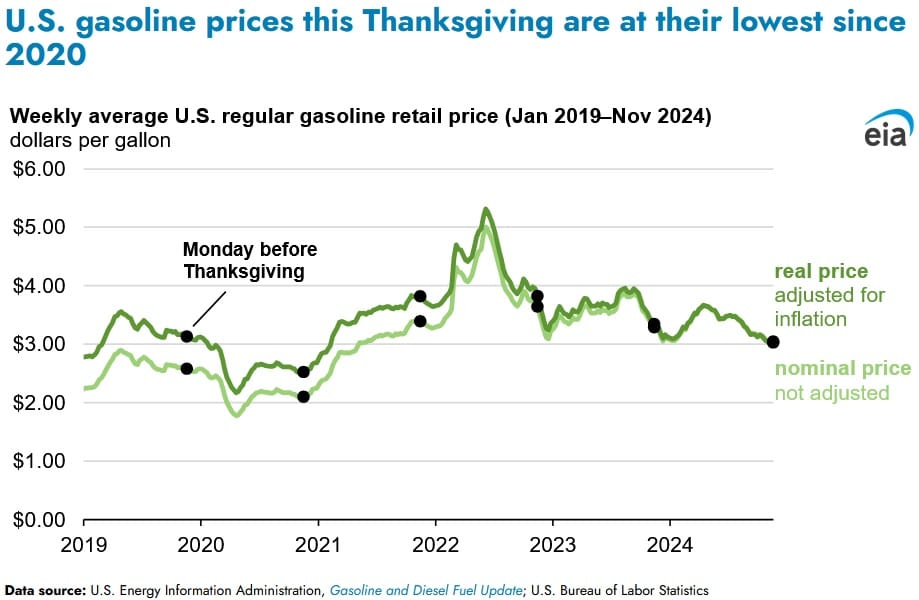U.S. Gasoline Prices at Their Lowest Level Since 2020 Heading into Thanksgiving Weekend: EIA

The retail price of regular gasoline, on the Monday before Thanksgiving averaged $3.04 per gallon (gal) across the U.S., down seven percent compared to the same time during 2024, according to a Nov. 27 report published by the U.S. Energy Information Administration. Heading into the Thanksgiving weekend, retail gasoline prices are at their lowest level since 2020, when the COVID 19 pandemic interrupted gasoline demand.
The American Automotive Association projects around 80 million individuals to travel in excess of 50 miles during the Thanksgiving break, up two percent compared to last year. Historically, U.S. retail gasoline prices follow a seasonal trend, where prices increase in the spring, before peaking in late summer, when driving demand is higher and then decline before winter. During 2024, lower crude oil prices and declining refining margins are supporting the historical trend and driving gasoline prices lower.
Lower gasoline prices during 2024 can be attributed to the slowing down of Chinese economic growth, lower crude oil prices and weak growth in both U.S. and global petroleum product demand. Crude oil is a key driver of the gasoline price and the agency estimates that the crude oil price accounted for 53 percent of the gasoline price during September 2024. Gasoline, crude oil and other petroleum products are traded on the global wholesale market, and as a result are impacted by economic activity and events in significant consuming and producing countries. As an example, slower crude oil demand growth during 2024 in China compared to previous years has put a lid on gasoline prices.
Refining margins, which account on average for around 15 percent of the price of gasoline, usually decline in the fall when the yearly change to winter grade gasoline permits refiners to utilize cheaper components to produce gasoline. During 2024, relatively weak petroleum products demand and increases in global refining capacity are contributing to lower refining costs and helping bring down gasoline prices.
The price of U.S. gasoline varies across the different regions and depends largely on demand and supply fundamentals, differing fuel specifications necessitated by state laws and taxes. The West Coast has the highest gasoline prices, due to constricted local supply and demand fundamentals, limited interconnections with other refining centers and obligations for gasoline specifications that are more expensive to produce.
EnerKnol Pulses like this one are powered by the EnerKnol Platform—the first comprehensive database for real-time energy policy tracking. Sign up for a free trial below for access to key regulatory data and deep industry insights across the energy spectrum.
ACCESS FREE TRIAL


